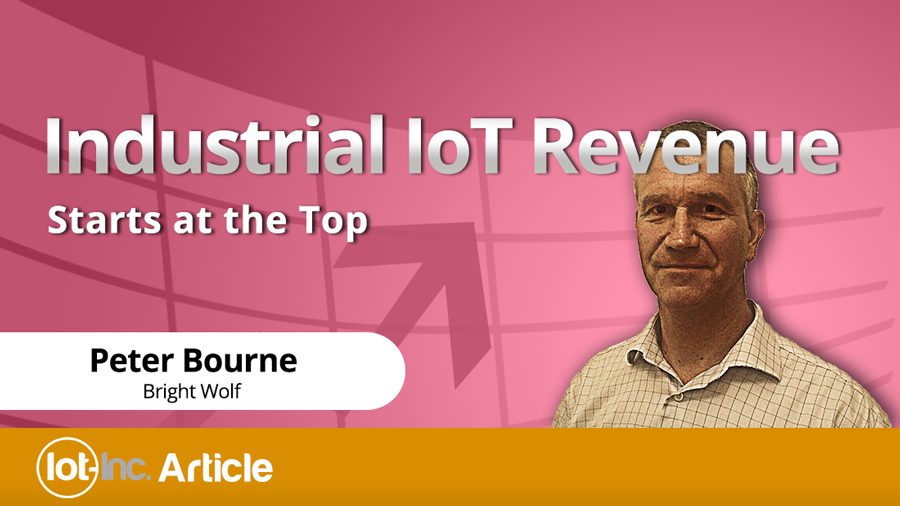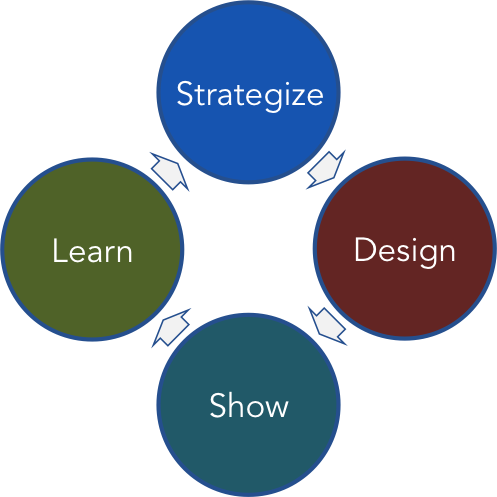
07 Jul Industrial IoT Revenue Starts at the Top
By Peter Bourne
With each passing day IoT becomes less of a technology problem, yet significant obstacles remain for enterprises seeking to create revenue opportunities through digital transformation. As the toolkits and vendor services available to organizations continue to progress, the critical path for realizing connected product ROI increasingly passes through product management and executive leadership, rather than engineering teams.
You’re going to be competing with their business model, which solves a complete problem for the customer to the point where that customer no longer even thinks of the new entrant as a competitor to you - it’s just a completely different category.
The industrial asset manufacturers who are winning greater market share today through IoT are those who have become ‘information’ companies – not ‘software’ companies. Information companies are data-centric organizations that start by asking “If we could no longer profitably sell our hardware, what new services could we provide to increase our total value to our customers and differentiate ourselves from the competition?” This is followed by “Now, what data do we need to collect and process in order to deliver these services?” Then they ensure their technology choices support these answers. Conversely, software-focused companies will invest 12-24 months building an IoT platform before determining specific commercialization strategies, then all too often find their pre-chosen architecture can’t adapt once they learn what their customers actually value.
The solution? Test for value first.
How well do you understand your customer’s workflows and pain points? Are there certain challenges, such as regulatory compliance, which you can solve for your customers with your connected products – and the information they make available – that your competitors cannot match with stand-alone hardware? This is what product managers and executive teams need to understand for achieving a market advantage and ROI through connected product initiatives.
The task at hand, then, is discovering the intrinsic value of your enterprise to your customers. In this next wave of competitive disruption, you’re not going to be competing with another industrial equipment provider’s newfangled or less expensive “Thing.” You’re going to be competing with their business model, which solves a complete problem for the customer to the point where that customer no longer even thinks of the new entrant as a competitor to you – it’s just a completely different category.
After many years of helping Fortune 1000 customers build and deploy connected solutions, our team at Bright Wolf has learned that successful digital transformation journeys start with the questions posed above, and work forward from there to design and build systems to deliver on that promise.
1. Show. Don’t Tell (or Ask)
Successful enterprises take an iterative approach, moving through a short cycle of strategize-design-show-learn, and showing their customers the future at every turn.
Asking your customers (e.g. a voice of the customer/market study) can help inform the strategy, but falls far short of providing enough understanding upon which to build a solution. Telling your customers about the future, with slides or other aids, is rarely enough to spark their imagination and truly propel the conversation. A customer responding “Sure, that’s interesting” doesn’t count as market validation or a signal to continue the project. If instead, however, you begin by showing your customers something, you ignite real engagement leading to true insights about their business, and your potential role in helping them grow.

2. Test for Value
This isn’t an engineering project. It’s not even the next version of your product. It’s a new offering, and the most important aspect of it is the economic impact for you and your customers.
While it can be challenging in a large company with decades or centuries of history, you have to set aside your product-driven process and adopt in its place a customer-driven approach (my personal favorite approach to this was captured by Steve Blank in his book “The Four Steps to the Epiphany” and is well worth the read if you’re creating a new product or service.)
Testing for value means getting a complete picture of your customer’s current situation, and then making absolutely certain they will be willing to pay for (not just use) your proposed solution.
Here’s a sample set of solution fit questions to ask during customer discovery:
- “What are your challenges now? I’d like to fully understand the problem you’re trying to solve.” Keep asking “tell me more about that” or “can you tell me what impact that has” or “what else” during the discussion.
- [If there isn’t a problem, no solution is needed!]
- “What solutions have you already tried to solve this challenge?”
- [If they haven’t tried anything yet, then the problem may not be acute.]
- “How did those alternative solutions fail to meet your needs?”
- [You’ll learn valuable information about the total purchasing criteria here.]
At some point in the iterative cycle, it’s time to ask the crucial value test question: “Would you pay $X for a solution to this problem that meets your criteria?” In the excitement of delivering early versions of the solution to prospective customers, we see all too often that this critical value test opportunity is missed, and replaced with weaker questions like “would you be willing to try this?” or “would this solution work for you?” Don’t fall into that trap.
Make sure you’re proving throughout your customer discovery process not just that there is technical merit to your new offering, but that it is commercially viable. The faster you can determine that, the better.
3. Integrate with Your Customers’ Systems
The promise of IoT is that you deliver value to your customers by aligning with their outcomes. To do so, your new connected offering must become part of your customers’ workflow, and not just part of their capital assets.
For some, this means you’ll need an increased understanding of how your customer runs their business: what are their KPIs; what systems do they use to manage and measure their outcomes; etc. In other cases, you may already be providing value-adding companion services to your customers, such as lab services to test the quality of their products, or to certify batches for a regulatory body. These existing services can provide a great springboard into determining the monetizable value of your connected product system.
Regardless of how you get there, finding a path to understanding your customers’ business well enough to know where you fit into their outcomes (rather than their consumption) is critical. This will likely require experimentation (as described above).
4. Organizational Success Patterns
Becoming an information company is an organizational and cultural journey as much as it is a technical and commercial one. From the beginning of the computing revolution, thinkers have observed that an organization’s structure and communication patterns will influence its product architecture. As this relates to industrial IoT, we’ve seen the greatest success in companies that factor out the common functions of their core IoT system into one team, while assigning the business logic and unique customer-facing aspects to those business unit groups that have the greatest insight into how your system will differentiate your company, and deliver value. This minimizes duplication of effort and enables each product team to innovate at their own pace on a secure and stable foundation, thereby increasing the odds of successful commercialization across your enterprise.
One of the most impactful things a company can do is bring their sales team into the process early on. Find a sponsor in your sales organization, and build up a small series of successes with that champion. Think of it as an internal case study. As you’re building the case study with your sales champion, you’re also working out the best offering, and building success incrementally. This way, when you roll out the product more broadly internally, you’ve got a pilot internal “customer” and a proven success template for others to adopt. Similarly, successful digital transformation cannot be achieved without support of the finance department, another constituent often left out until later in the process. Structuring payment plans, inventorying software, determining how to comp sales, and setting targets will all need working out for a successful commercial venture.
Focus on Commercial Value
Unlike several years ago when simply having a connected product system was enough to differentiate you from your competitors, today your solution must solve a meaningful problem for your customers and be differentiated from other potential solutions they may have access to. For well-established companies that dominate their industry, while digital skills can be a challenge, the greater challenge often lies in the cultural and process journey to innovation. Asking good questions, engaging with the customer early in the process, iterating quickly with the customer, keeping the engagement balanced toward business questions rather than technology capabilities, and integrating the solution with your customer’s workflow and processes are all required for a successful outcome.
The goal of digital transformation is to remain relevant in a changing world by providing more value to your customers through differentiated connected products and services than your competitors can offer them. This requires a shift in organizational thinking at the product management and executive leadership levels, and new interactions between teams across the enterprise.
In the end, companies with stand-alone hardware will be commoditized and locked out of the market. Companies with connected products built by engineering teams without broad company support will also fail to transform, and be replaced in the market by those with more integrated commercialization strategies. As history has shown during previous waves of industrial revolutions, changes of this magnitude can only begin at the top.
Peter is the CEO of Bright Wolf, an enterprise IoT partner for industrial equipment providers.
Have an opinion? Join the discussion in our LinkedIn group
How can you become a critical part of your customers' workflows?
Click here if you have an opinion on this podcast or want to see the opinion of others





